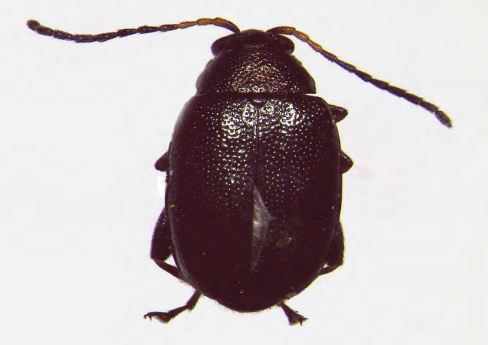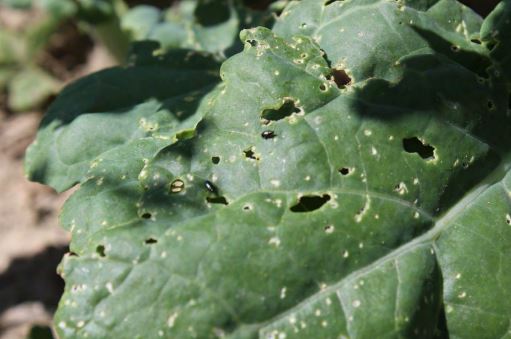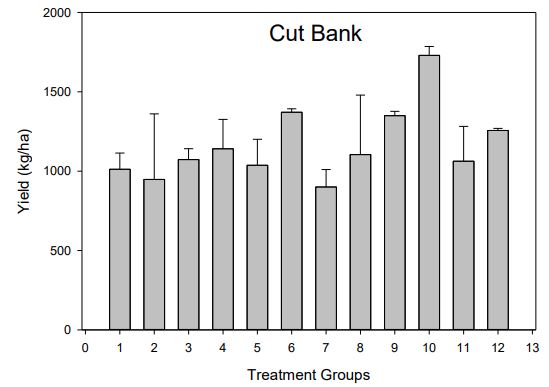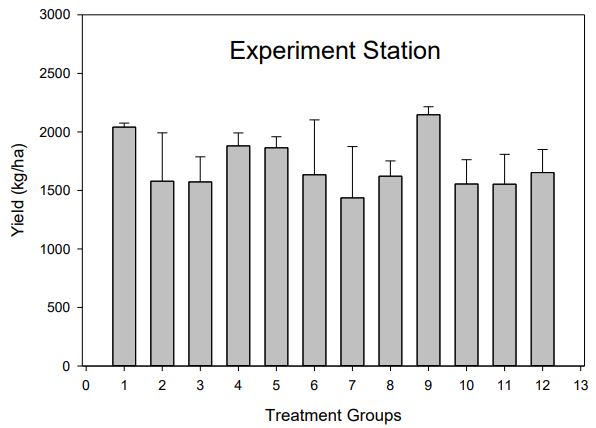Efficacy of Entomopathogenic Nematodes on Canola Flea Beetle, Phyllotreta cruciferae (Goeze) (Coleoptera: Chrysomelidae)
Principle Investigator: Dr. Gadi V.P. Reddy
Cooperators: Dr. Brian Thompson, Dr. Sindhu Krishnankutty, John Miller, Julie Prewitt
Western Triangle Agricultural Research Center, Montana State University, 9546 Old Shelby Rd.,
P.O. Box 656, Conrad, MT 59425, USA
Background
Entomopathogenic nematodes are an attractive alternative to chemical control measures for flea beetles Phyllotreta cruciferae (Figure 1). Flea beetles cause extensive damage in canola crops early in the growing season by chewing holes in leaves, stunting growth and even killing young plants (Figure 2). Entomopathogenic nematodes were tested for their ability to control flea beetle populations in three locations (Cut Bank, Sunburst, Western Triangle Ag Research Center) in the golden triangle area of Montana in 2014. The four species of nematode used were applied at ~230,000 nematodes/m2 alone and in the presence of a bioprotectant (Barricade®) designed to prolong the survival of the nematode in the foliar environment. In Observed differences for canola yield in this study represent the impact of growing conditions, weather events and pest pressure. Differences between in field conditions were great enough (p < 0.05) that locations were analyzed separately. The application of nematodes did not significantly alter yield for study plots compared to the control in any field examined. These results suggest nematodes are not a reliable control measure for foliar pests of canola, such as flea beetles.
Materials and Methods
Three locations were selected for this trial, one at WTARC (N48˚18’.24.88 W111˚55’28.45), another north of Cutbank (N48˚83’39.08, W112˚29’40.25) and another east of Sunburst (N 48˚88’56.69, W111˚65’45.63). Canola was planted in May of 2014. Nematode treatments were applied using hand held sprayers held ~10cm above the seedling canola. Nematodes were mixed on site 15min prior to spraying to a concentration of ~230,000 nematodes/m2. Nematode species used were Steinernema carpocapsae, S. kraussei, S. feltiae, Heterorhabditis bacteriophora.
These species were used individually and in the case of S. carpocapsae there were additonal treatments in combination with S. feltiae and H. bacteriophora. In additon to pure nematode treatments mixed with water, nematodes were also applied individually in a tank mix with the fire retarded gel Barricade®. Barricade traps moisture and was used at a concentration of 2% when applied. Water control and Barricade control were applied at the same time as nematodes for comparison. Each of the 12 treatments was applied to 3 plots at each location for a total of n=108 plots. Nematodes were obtained from BASF, Ames, Iowa. Canola was planted at a rate of 12 seeds/ 30cm using a four row seed drill. At all locations, rows within the plots were spaced 0.3m apart, and the herbicide Roundup Powermax (Glyphosate) at the rate of 2.5 L/ha was applied before planting for weed control. Fertilizer N, P,K and S ratio was applied at 134.5, 25.2, 61.6, and 22.4 kg/ha at actual time of planting and an additional application of 12.3, 25.2, and 0 kg/ha was broadcast through the seed plot drill. For each experiment , the treatment plots were arranged in a completely randomized block design with three replicates. No irrigation was used as the trials were conducted under dry conditions.
Results
The three study locations showed statistically different yield (kg/ha) (Tukey HSD p<0.001; Figure 3). As such all subsequent analyses of yield were carried out separately for each location. Yield was highly variable among the study locations. Cutbank was the lowest yielding. This location received extensive hail damage during pod development. No statistical differences were observed between any of the treatments at this study location (Figure 4). There were no significant differences when all treatments were compared together nor when barricade and non- barricade treatments were compared separately. The same was true for both Sunburst and Western Triangle Research Center location (Figure 5&6 respectively). The number of flea beetles generally declined throughout the season, but no declines differed markedly from the control treatment (Figures 7,8&9).
Discussion
Flea beetles are a major pest of canola. In the seedling stage, heavy flea beetle feeding can cause stunting and even death of the plant. Flea beetles continue to feed on canola throughout the growing season and do damage seed pods, but are most destructive to seedling plants. Our previous studies indicated the effectiveness of nematodes against flea beetles on canola (Reddy et al. 2014. J. Econ. Entomol. 107: 661-666). However, the current study aimed to investigate the prolonged effectiveness of nematodes using a desiccation barrier (Barricade). There were no observed differences between treatments with and without Barricade in this study. A follow up study on the promising results from 2013 amended with information from 2014 will be carried out in 2015.
Acknowledgements
Funding for this research was provided by U.S. Department of Agriculture-National Institute of Food and Agriculture (USDA-NIFA) Hatch (#MONB00859). We also like to thank Phil Aschim, Bow & Arrow Ranch, Sunburst and Kevin Bradley, Cut Bank, for providing fields for our experiments.
Figures
Figure 1: Adult flea beetle Phyllotreta cruciferae
Figure 2: Flea beetles and their feeding damage on mature canola leaves
Figure 3: Yield (kg/ha) for canola fields at the various study locations were significantly different (Tukey HSD p < 0.001).
Figure 4: Yield (kg/ha) at Cut Bank location. 1) Barricade 2) Barricade + H. bactiophora 3) Barricade + S. carpocapsae 4) Barricase + S. feltiae 5) Barricade + S. kraussei 6) Control 7) H. bacteriophora 8) S. carpocapsae 9) S. carpocapsae + H. bacteriophora 10) S. carpocapsae 11) S. feltiae 12) S. kraussei, No difference observed between any barricade treatments (Tukey HSD >0.05).
Figure 5: Yield at Sunburst (kg/ha); 1) Barricade 2) Barricade + H. bactiophora 3) Barricade + S. carpocapsae 4) Barricase + S. feltiae 5) Barricade + S. kraussei 6) Control 7) H. bacteriophora 8) S. carpocapsae 9) S.carpocapsae + H. bacteriophora 10) S. carpocapsae 11) S. feltiae 12) S. kraussei; No significance difference detected across all treatments. There is no difference in the treatments that do not include barricade. There is no significant difference in the treatments that do include barricade (Tukey HSD p>0.05).
Figure 6: Yield WTARC (kg/ha); 1) Barricade 2) Barricade + H. bactiophora 3) Barricade + S. carpocapsae 4) Barricase + S. feltiae 5) Barricade + S. kraussei 6) Control 7) H. bacteriophora 8) S. carpocapsae 9) S. carpocapsae + H. bacteriophora 10) S. carpocapsae 11) S. feltiae 12) S. kraussei; No significance difference detected across all treatments. There is no difference in the treatments that do not include barricade. There is no significant difference in the treatments that do include barricade (Tukey HSD p>0.05).
Figure 7: The mean number of flea beetles in each treatment over the course of the study at the Cut Bank location. No significant difference were found between treatments.
Figure 8: The mean number of flea beetles in each treatment over the course of the study at the Sunburst location. No significant difference were found between treatments.
Figure 9: The mean number of flea beetles in each treatment over the course of the study at the experimental research station location (WTARC). No significant difference were found between treatments.









